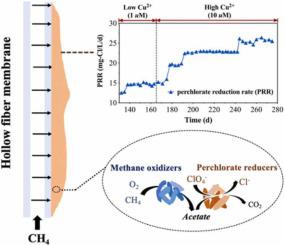Journal of Hazardous Materials ( IF 12.2 ) Pub Date : 2021-11-27 , DOI: 10.1016/j.jhazmat.2021.127917 Yulu Wang 1 , Chun-Yu Lai 1 , Mengxiong Wu 1 , Xuanyu Lu 1 , Shihu Hu 1 , Zhiguo Yuan 1 , Jianhua Guo 1

|
The present study demonstrated that the perchlorate reduction rate in a methane-based membrane biofilm reactor was significantly enhanced from 14.4 to 25.6 mg-Cl/L/d by increasing copper concentration in the feeding medium from 1 to 10 M, indicating a stimulatory effect of copper on the methane-supported perchlorate reduction process. Batch tests further confirmed that the increased copper concentration enhanced both methane oxidation and perchlorate reduction rates, which was supported by an increasing trend of functional genes (pmoA for methanotrophs and pcrA for specific perchlorate reducers) abundances through quantitative PCR (qPCR). Both 16S rRNA gene sequencing and functional gene (pmoA and pcrA) sequencing jointly revealed that the biofilm supplied with a higher copper concentration exhibited a more diverse microbial community. The methane-supported perchlorate reduction was accomplished through a synergistic association of methanotrophs (Methylocystis, Methylomonas, and Methylocystaceae) and perchlorate reducers (Dechloromonas, Azospira, Magnetospirillum, and Denitratisoma). Acetate may function as the key syntrophic linkage between methanotrophs and perchlorate reducers. It was proposed that the increased copper concentration improved the activity of particulate methane monooxygenase (pMMO) for methane oxidation or promoted the biosynthesis of intracellular carbon storage compounds polyhydroxybutyrate (PHB) in methanotrophs for generating more acetate available for perchlorate reduction.
中文翻译:

铜对膜生物膜反应器中甲烷负载高氯酸盐还原的促进作用
本研究表明,通过将进料介质中的铜浓度从 1 增加到 10,甲烷基膜生物膜反应器中的高氯酸盐还原率从 14.4 到 25.6 mg-Cl/L/d 显着提高M,表明铜对甲烷负载的高氯酸盐还原过程有促进作用。批量测试进一步证实,增加的铜浓度提高了甲烷氧化和高氯酸盐还原率,这得到了通过定量 PCR (qPCR)功能基因(甲烷氧化菌的pmoA和特定高氯酸盐还原剂的pcrA )丰度增加趋势的支持。16S rRNA 基因测序和功能基因(pmoA和pcrA)测序共同表明,提供更高铜浓度的生物膜表现出更多样化的微生物群落。甲烷支持的高氯酸盐还原是通过甲烷氧化菌的协同联合完成的(甲基囊菌属、甲基单胞菌属和甲基囊菌科)和高氯酸盐还原剂(脱氯单胞菌属、固螺菌属、磁螺菌属和反硝化菌属)。乙酸盐可以作为甲烷氧化菌和高氯酸盐还原剂之间的关键互养联系。有人提出,增加的铜浓度提高了颗粒甲烷单加氧酶 (pMMO) 对甲烷氧化的活性,或促进了甲烷氧化菌中细胞内碳储存化合物聚羟基丁酸酯 (PHB) 的生物合成,从而产生更多可用于还原高氯酸盐的乙酸盐。











































 京公网安备 11010802027423号
京公网安备 11010802027423号